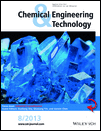Solvent Effect on Crystal Structure of Tetracycline Hydrochloride
X. Hu
Tianjin University, National Engineering Research Center of Industrial Crystallization Technology, School of Chemical Engineering and Technology, Tianjin, China
Search for more papers by this authorY. Wang
Tianjin University, National Engineering Research Center of Industrial Crystallization Technology, School of Chemical Engineering and Technology, Tianjin, China
Tianjin University, Tianjin Key Lab of Modern Drug Delivery and High Efficiency, Tianjin, China
Search for more papers by this authorY. Zhao
Tianjin University, National Engineering Research Center of Industrial Crystallization Technology, School of Chemical Engineering and Technology, Tianjin, China
Search for more papers by this authorG. Wang
Tianjin University, National Engineering Research Center of Industrial Crystallization Technology, School of Chemical Engineering and Technology, Tianjin, China
Search for more papers by this authorY. Bao
Tianjin University, National Engineering Research Center of Industrial Crystallization Technology, School of Chemical Engineering and Technology, Tianjin, China
Search for more papers by this authorCorresponding Author
C. Xie
Tianjin University, National Engineering Research Center of Industrial Crystallization Technology, School of Chemical Engineering and Technology, Tianjin, China
Tianjin University, National Engineering Research Center of Industrial Crystallization Technology, School of Chemical Engineering and Technology, Tianjin, ChinaSearch for more papers by this authorX. Hu
Tianjin University, National Engineering Research Center of Industrial Crystallization Technology, School of Chemical Engineering and Technology, Tianjin, China
Search for more papers by this authorY. Wang
Tianjin University, National Engineering Research Center of Industrial Crystallization Technology, School of Chemical Engineering and Technology, Tianjin, China
Tianjin University, Tianjin Key Lab of Modern Drug Delivery and High Efficiency, Tianjin, China
Search for more papers by this authorY. Zhao
Tianjin University, National Engineering Research Center of Industrial Crystallization Technology, School of Chemical Engineering and Technology, Tianjin, China
Search for more papers by this authorG. Wang
Tianjin University, National Engineering Research Center of Industrial Crystallization Technology, School of Chemical Engineering and Technology, Tianjin, China
Search for more papers by this authorY. Bao
Tianjin University, National Engineering Research Center of Industrial Crystallization Technology, School of Chemical Engineering and Technology, Tianjin, China
Search for more papers by this authorCorresponding Author
C. Xie
Tianjin University, National Engineering Research Center of Industrial Crystallization Technology, School of Chemical Engineering and Technology, Tianjin, China
Tianjin University, National Engineering Research Center of Industrial Crystallization Technology, School of Chemical Engineering and Technology, Tianjin, ChinaSearch for more papers by this authorAbstract
The crystal structure of tetracycline hydrochloride was simulated by Bravais-Friedel-Donnay-Harker (BFDH) and modified attachment energy (AE) models, based on the single-crystal data obtained by Material Studio software. A comparison to the scanning electron microscopy image of tetracycline hydrochloride indicated that the AE model was superior to the BFDH model. The morphology predicted by the AE model was further improved by taking account of the interaction effect between the growing faces and the solvent molecules. The final modification of the AE prediction provided good accordance with the observed results of the experiments.
References
- 1 I. Chopra, M. Roberts, Microbiol. Mol. Biol. Rev. 2001, 65 (2), 232–260.
- 2 A. N. Sapadin, R. Fleischmajer, J. Am. Acad. Dermatol. 2006, 54, 258–265.
- 3 A. Millan, O. Sohnel, F. Grases, J. Cryst. Growth 1997, 179, 231.
- 4 G. D. Gu, T. Egi, N. Koshizuka, P. A. Miles, G. J. Russell, S. J. Kennedy, Physica C 1996, 263, 180.
- 5 J. Prywer, J. Cryst. Growth 1997, 197, 271–285.
- 6 J. Prywer, J. Cryst. Growth 2001, 224, 134–144.
- 7 I. Hod, Y. Mastai, D. D. Medina, Cryst. Eng. Commun. 2011, 13, 502–509.
- 8 R. B. Romero, C. A. P. Leite, M. do Carmo Goncalves, Polymer 2009, 50, 161–170.
- 9 J. Puigmarti-Luis, Á. P. del Pino, V. Laukhin, L. N. Feldborg, C. Rovira, E. Laukhina, D. B. Amabilino, J. Mater. Chem. 2010, 20, 466–474.
- 10 C. Stoica, P. Verwer, H. Meekes, P. J. C. M. van Hoof, F. M. Kaspersen, E. Vlieg, Cryst. Growth Des. 2004, 4 (4), 765–768.
- 11 M. Ma, W. Ye, X. X. Wang, Mater. Lett. 2008, 62, 3875–3877.
- 12 D. Z. Yang, A. N. Hrymak, Ind. Eng. Chem. Res. 2011, 50 (20), 11585–11593.
- 13 Y. L. Wang, H. T. Jiang, L. J. Liu, J. K. Wang, J. Tianjin Univ. 2007, 40 (3), 294–298.
- 14 D. S. Coombes, C. R. A. Catlow, J. D. Gale, M. J. Hardy, M. R. Saunders, J. Pharm. Sci. 2002, 91 (7), 1652–1658.
- 15 P. Hartman, P. Bennema, J. Cryst. Growth 1980, 49, 145.
- 16 J. J. Lu, J. Ulrich, Cryst. Res. Technol. 2003, 38 (1), 63–73.
- 17 R. B. Hammond, K. Pencheva, V. Ramachandran, K. J. Roberts, Cryst. Growth Des. 2007, 7 (9), 1571–1574.
- 18 J. Chen, B. L. Trout, Cryst. Growth Des. 2010, 10, 4379–4388.
- 19
C. Schmidt,
J. Ulrich,
Chem. Eng. Technol.
2012,
35 (6),
1009–1012.
10.1002/ceat.201100654 Google Scholar
- 20 A. E. Glikin, L. Y. Kryuchkova, V. D. Franke, Chem. Eng. Technol. 2011, 34 (4), 587–592.




